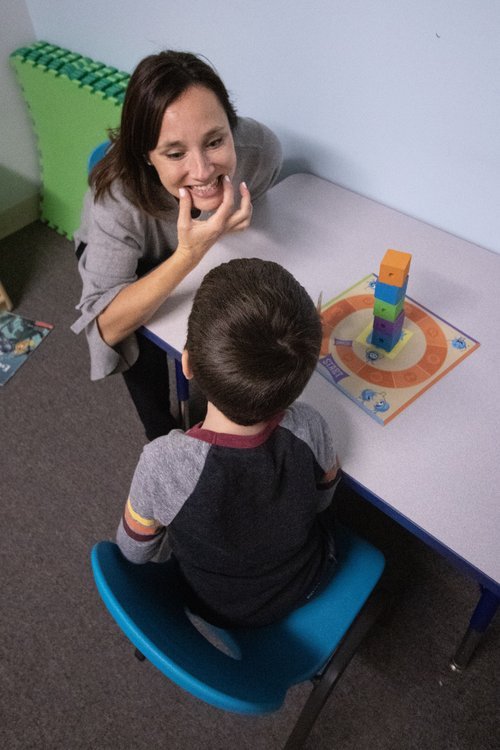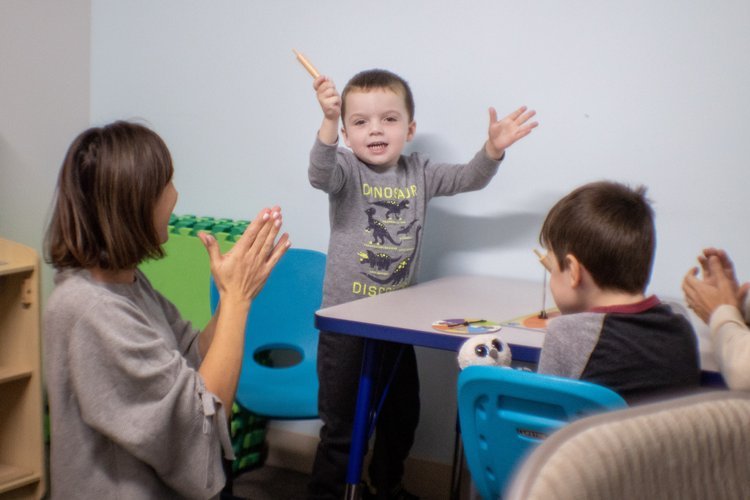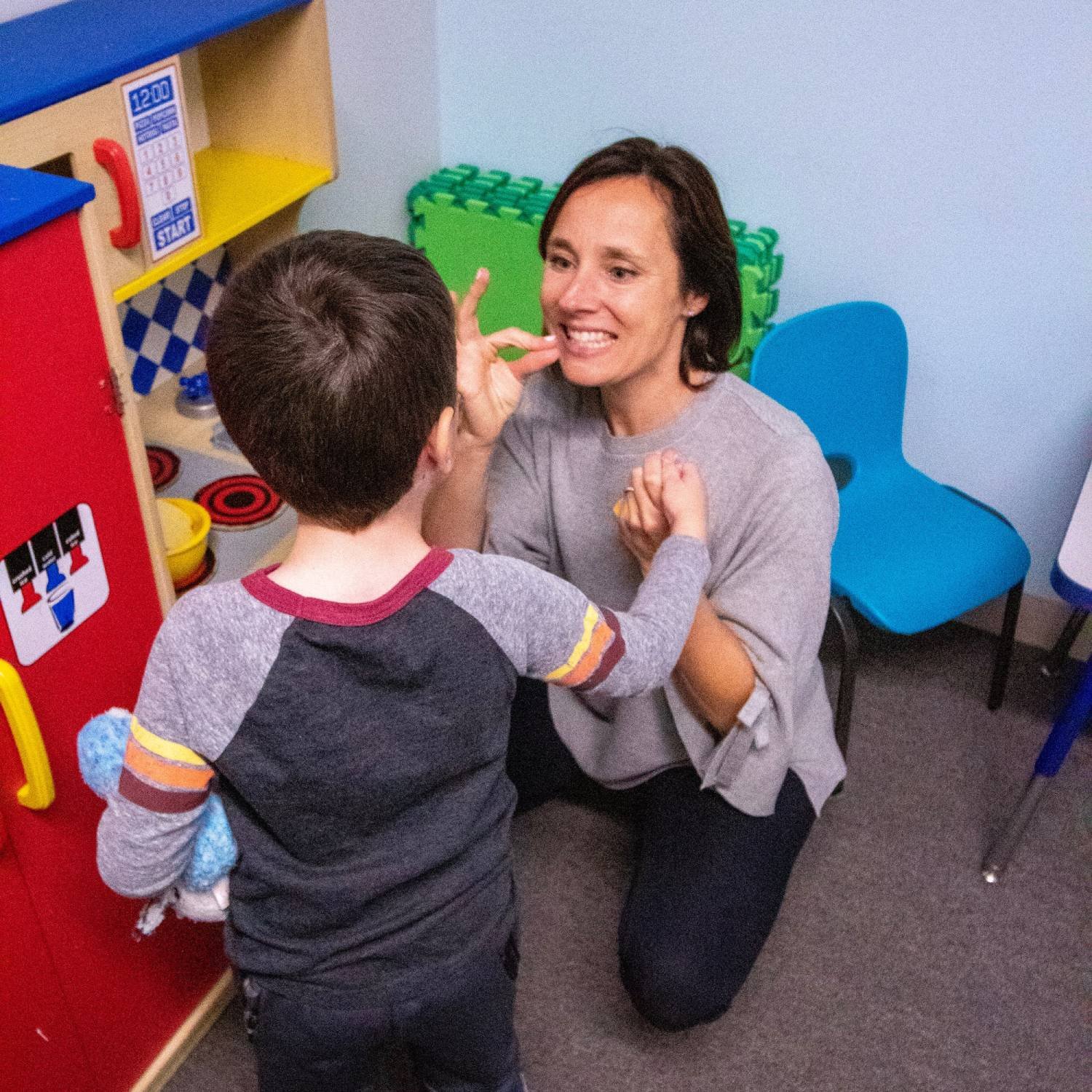Pediatric Speech Therapy
Helping children become successful communicators with the world around them.
How Speech Therapy Affects Kids
The ability to communicate is necessary to having needs met and developing deep connections with the world around you. Whether through improving articulation, building verbal language skills, or introducing an augmentative or alternative communication form, speech therapy unlocks a child’s ability to connect with caregivers, siblings, playmates, and beyond.
Speech Therapy at Buttonloop
Speech therapy encompasses articulation, expressive language, receptive language, and social pragmatic language skills. We work in a play-based approach, moving a child from where they are, offering scaffolding, and helping them realize their fullest potential.
Our pediatric speech therapists have specialized training in:
-
PROMPT (PROMPTS for Restructuring Oral Muscular Phonetic Targets) Therapy
-
Dynamic Temporal and Tactile Cueing (DTTC)
-
Kaufman Apraxia Therapy
-
Lee Silverman Voice Treatment (LSVT LOUD)
-
Velopharyngeal Insufficiency (VPI)
-
SOS Approach to Feeding Therapy
-
Social Thinking
-
Alternative and Augmentative Communication (AAC)
-
Lively Letters
-
Executive Function
-
SKILL Narrative
-
Play & Language: The Roots of Literacy
Speech therapy may be beneficial if your child demonstrates any of the following:
Speech understood by others less than 50% of the time by two and understood by others less than 80% of the time by three
Missing consonants from the beginning of words
Shows frustration around communication
Fewer than 50 words or lack of two-word combinations by 18 months of age
Cannot point to body parts or follow simple commands by 15 months of age
Does not respond to his/her name or make eye contact frequently
Does not participate in reciprocal games, such as peek a boo
Has difficulty using toys for their intended purpose, for example, turning a bus upside down and spinning wheels rather than driving it back and forth
How We Help Children with Speech Problems
Orofacial Myofunctional Disorders
Orofacial myofunctional disorders (OMDs) are abnormal movement patterns of the face and mouth. OMDs can be the source of problems, such as drooling beyond two years of age, tongue thrust, or open mouth posture/forward tongue carriage.
Developmental Language Disorder Treatment & Evaluation
Language is broken down into two components, receptive and expressive. Receptive language refers to a child’s understanding of language. It can be observed in your child’s response to questions or ability to complete directions. Expressive language refers to a child’s use of language. It can be seen in the vocabulary, grammar, and length of utterance. Vocabulary weaknesses may be exhibited in receptive and expressive language skills and may be associated with decreased vocabulary or retrieval difficulties.
Childhood Onset Fluency Disorder and Stuttering
Stuttering affects the fluency of speech and may include prolongations, blocks, sound or word repetitions, interjections, or circumlocutions.
Speech Apraxia
Childhood Apraxia of Speech is a motor speech disorder characterized by difficulty in planning and producing the precise articulatory patterns required to form intelligible speech. Our clinicians have participated in a number of trainings specializing in the treatment of CAS. We are also quite fortunate to have a provider listed on Apraxia Kids Speech-Language Pathologist Directory.
Phonological Awareness
Phonological Awareness refers to multi-level skills, including the child’s ability to hear and manipulate the sound structure of a letter or word. These skills are essential to the reading process and may or may not be impacted by articulation or phonological delays.
Speech Articulation Disorder
Articulation refers to sound production or the way that air or voice is moved through a child’s articulators, including the tongue, lips, teeth, and nose.
AAC (Alternative and Augmentative communication)
AAC is the use of alternative means of communication, outside of spoken voice, that provides a child an opportunity to successfully communicate. Research shows that using alternative and augmentative forms of communication allow children to build positive experiences around communication. These successful interactions, coupled with participation in the therapy actually increase the likelihood that a child will develop spoken language.
Speech Therapy Testimonial
“Within a matter of a month or two, I saw progress in my son’s speech. Suddenly, I could understand most of what he was telling me. His articulation improvement was even noticed by friends and family. We were elated, and so very relieved, to know that the therapy was not only working, but working incredibly well… and fast!”
— Stephanie M., Melrose, MA






There are a 3 ways to get started with Buttonloop Children’s Therapies.
No matter where you are on your journey, we can help.
If you are ready to get started and book an appointment, please choose:
Option 1
Complete our intake form, and we can move forward with scheduling your initial appointment.
If you are wondering if therapy could be helpful and would like to speak with a clinician, please choose:
Option 2
Book a free 10-minute phone consultation with a clinician.
If you’d like someone from our team to reach out to you directly, please choose:
Option 3
Fill out the contact form, and we will contact you by phone or email.










